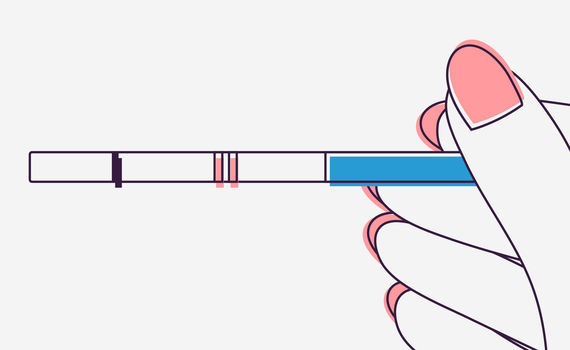
Path To Pregnancy
The Best Time To Take a Pregnancy Test
Hannah Loeffelmann
6/29/2020
7 min
When doing a pregnancy test, timing is everything. And not only the right time in your cycle plays an important role, but also the time of day.
Tightness in the breasts and sudden nausea in the morning: There are many signs that can indicate a pregnancy- but none is as clear as the absence of menstruation. Now at the latest it is time for a pregnancy test. But does it provide reliable results even before that? When is the pregnancy test worthwhile? We have answers for you below.
At what point does it make sense to take a pregnancy test?
Pregnancy is determined at an early stage by the concentration of hCG (human chorionic gonadotropin) in the body. This hormone is produced by healthy women during pregnancy - and this already a few days after the egg has been successfully fertilized. Among other things, this pregnancy hormone prevents rejection of the uterine lining and the onset of menstruation. But at what point a pregnancy test is really reliable depends on which type of test you choose.
Different types of pregnancy tests**
Blood test: hCG can be detected in the blood as early as six to nine days after fertilization - and thus before menstruation stops. The examination can be carried out by a gynaecologist, the test result should be available after about 24 hours.
Early urine test: About four days before the next period is due, so-called early urine tests can also be used, which are available in pharmacies and drugstores. Here the hCG value is measured via your urine. However, as the error rate of these tests is quite high, it is recommended that the test should only be applied when your period is overdue.
Urine test: The normal urine pregnancy test provides a very reliable result around 14 days after fertilisation of the egg, i.e. around the time of when your period would actually be due. The reliability is usually 90 to 99 percent.
Ultrasound: A few days after the period is missed at the earliest, a pregnancy can also be determined by ultrasound from a gynaecologist. Then a small amniotic cavity in the uterus can be detected.
Test with morning urine
One of the most common ways to detect pregnancy is with a urine rapid test. It is the only test that can also be carried out at home as a self-test. The costs are manageable and it is available in most pharmacies, drugstores and some supermarkets. Good to know: The price for early tests is usually much higher - but as is the error rate.
There are different types of urine pregnancy tests. You can choose between midstream, cassette or strip tests, which vary only slightly in terms of how they work. In the latter, for example, a test strip of absorbent tissue is immersed in the urine or held directly in the urine stream. It is best to use morning urine for a pregnancy test, as the hCG concentration is highest at this time of day.
On the strip itself there are hCG antibodies that react with the hormone in the urine and make a pregnancy visible with the help of a dye, for example as a line or plus sign. You have to wait about five minutes until the urine test gives a result. By the way: If the test is only slightly positive, i.e. the line, plus or the word "pregnant" is only slightly visible, it is still a positive test result. It merely indicates a low hCG concentration in the urine. In case of doubt, the test should be repeated at a later date.
Many strips also have a control field on them to indicate whether the test has been performed correctly. For those who want to know more: some pregnancy tests are also equipped with a “week indicator”, which shows the time since fertilization. Other tests display the result digitally, for example with the words "pregnant" or "not pregnant". The way these tests work, however, is no different from conventional test strips. However, for all pregnancy tests, read and follow the instructions carefully to obtain a correct result.
Pregnancy test false-positive
If a pregnancy is detected by an urine test, the probability is quite high that the result is correct. However, no test offers 100% reliability, so that in some cases, for example, a false-positive result may occur. Reasons for this can be:
- Error in the application of the test
- Use of the test after the expiry date
- Incorrect storage of the test (e.g. at too high temperatures)
- Taking some medications can affect hormone levels.
- In rare cases, cancer can also lead to an increased hCG level.
Taking a pregnancy test before your period isn’t always accurate
Most women first check a possible pregnancy by a quick urine test at home. If the result is negative, a pregnancy is not yet completely ruled out: Maybe the hCG level in the blood was still too low or the test was applied too early or not correctly. Other reasons for a false negative test result could be, for example, that an egg that has not yet been implanted or a high number of bacteria in the urine. Also- pregnancy is possible even despite a period. To be on the safe side, the test should be repeated a few days later. If it is still negative but the pregnancy symptoms persist, it is advisable to make an appointment with your doctor.
If the pregnancy test is positive, you should also see your gynaecologist. Here the pregnancy is checked once again and prenatal care is initiated.
Good to know: Next to 15 Luteinizing Hormone and 15 Follicle- Stimulating Hormone tests, your Pearl Fertility Kit also includes two pregnancy tests!


Path To Pregnancy

